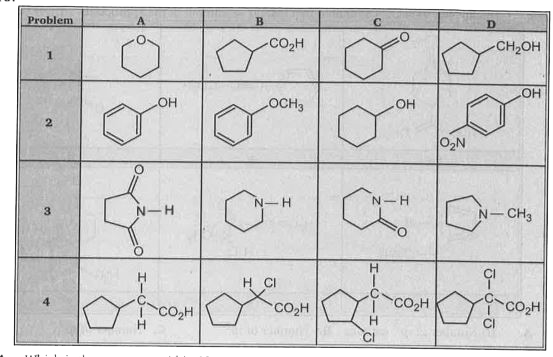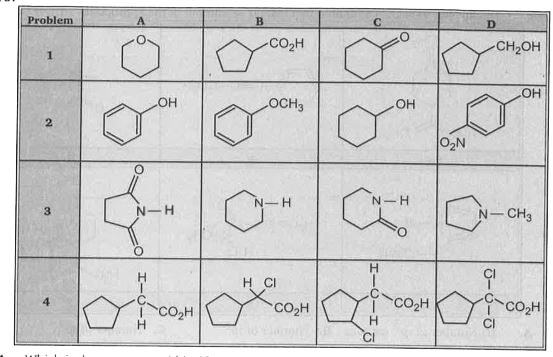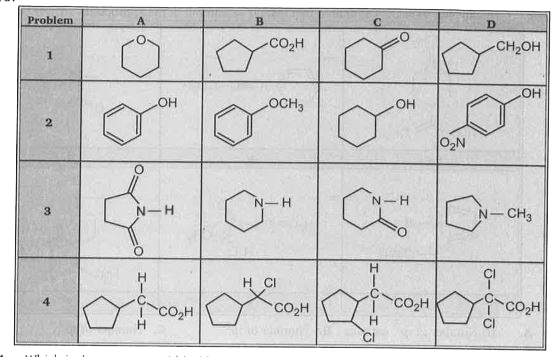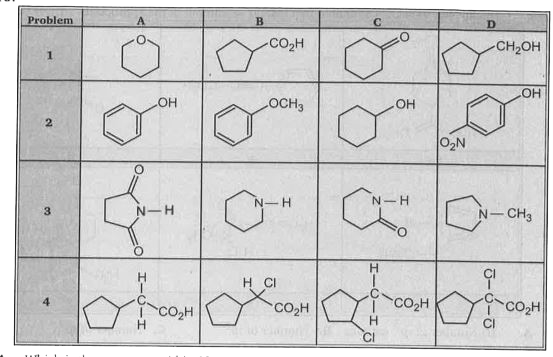Out of all the halogen hydracids, the weakest hydracid is:
HI
HBr
HF
HCl
The correct Answer is:C
To determine the weakest halogen hydracid among HF, HCl, HBr, and HI, we need to analyze their ability to donate H⁺ ions. Here's a step-by-step solution:
Step 1: Understand the Definition of Acids
An acid is defined as a substance that can donate H⁺ ions. The strength of an acid is determined by how easily it can donate these ions.
Hint: Remember that strong acids dissociate completely in solution, while weak acids do not.
Step 2: Identify the Halogen Hydracids
The halogen hydracids in question are:
- HF (Hydrofluoric acid)
- HCl (Hydrochloric acid)
- HBr (Hydrobromic acid)
- HI (Hydriodic acid)
Hint: List the acids clearly to avoid confusion later.
Step 3: Analyze Bond Strength
The bond strength between hydrogen and the halogen in each acid affects how easily the acid can donate H⁺ ions. As we move down the group in the periodic table, the size of the halogen increases, leading to weaker H-X bonds:
- HF: Strong bond (small size of F)
- HCl: Weaker bond than HF
- HBr: Weaker bond than HCl
- HI: Weakest bond (largest size of I)
Hint: Consider how atomic size affects bond strength; larger atoms lead to weaker bonds.
Step 4: Determine Bond Dissociation Enthalpy
The bond dissociation enthalpy is the energy required to break the bond and release H⁺ ions. Weaker bonds require less energy to break:
- HI has the weakest bond and thus the lowest bond dissociation enthalpy, making it the strongest acid.
- HF has the strongest bond and thus the highest bond dissociation enthalpy, making it the weakest acid.
Hint: Recall that lower bond dissociation enthalpy means the acid is stronger because it can release H⁺ ions more easily.
Step 5: Conclusion
Based on the analysis of bond strength and dissociation enthalpy, HF is the weakest halogen hydracid because it does not release H⁺ ions easily compared to the others.
Final Answer: The weakest halogen hydracid is HF.
An acid is defined as a substance that can donate H⁺ ions. The strength of an acid is determined by how easily it can donate these ions.
The halogen hydracids in question are:
- HF (Hydrofluoric acid)
- HCl (Hydrochloric acid)
- HBr (Hydrobromic acid)
- HI (Hydriodic acid)
The bond strength between hydrogen and the halogen in each acid affects how easily the acid can donate H⁺ ions. As we move down the group in the periodic table, the size of the halogen increases, leading to weaker H-X bonds:
- HF: Strong bond (small size of F)
- HCl: Weaker bond than HF
- HBr: Weaker bond than HCl
- HI: Weakest bond (largest size of I)
The bond dissociation enthalpy is the energy required to break the bond and release H⁺ ions. Weaker bonds require less energy to break:
- HI has the weakest bond and thus the lowest bond dissociation enthalpy, making it the strongest acid.
- HF has the strongest bond and thus the highest bond dissociation enthalpy, making it the weakest acid.
Based on the analysis of bond strength and dissociation enthalpy, HF is the weakest halogen hydracid because it does not release H⁺ ions easily compared to the others.
Topper's Solved these Questions
Similar Questions
Knowledge Check
- Question 1 - Select One

Which is weakest acid in 3 ?AABBCCDD - Question 2 - Select One

Which is weakest acid in 2 ?AABBCCDD - Question 3 - Select One

Which is weakest acid in 4 ?AABBCCDD


